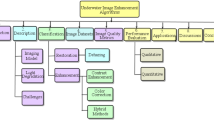Abstract
Image segmentation is one of the basic strategies in image analytics. It is used for pattern detection, photo montage and object recognition applications. In underwater images light scrambling, suspended particles that exhibit in the water, marine snow, and color deviations etc. are some of the issues for image acquisition. Due to these issues, all the segmentation algorithms invariably produce poor results in the case of underwater images. We propose an efficient algorithm for extracting the foreground region from the underwater images based on a region of interest. Our segmentation procedure for underwater images includes color correction, contrast enhancement followed by an interactive GrabCut algorithm. Inclusion of color correction and contrast enhancement minimizes the number of touch ups required to enhance the segmentation when compared to GrabCut algorithm without these preprocessing steps. Our algorithm is efficient in the sense of time, when compared to the other algorithms for the same purpose.












Similar content being viewed by others
References
Otsu, N. (1979). A threshold selection method from gray-level histograms. IEEE Transactions on Systems, Man, and Cybernetics, 9(1), 62–66.
Sankar Reddy, A., Usha Rani, C., & Sudhakar, M. (2017). An effective thresholding for Otsu’s method using contrast enhancement. International Journal of Engineering Science, 6(8), 22296–22304.
Canny, J. (1986). A computational approach to edge detection. IEEE Transactions on Pattern Analysis and Machine Intelligence, 8(6), 679–698.
Vincent, L., & Soille, P. (1991). Watersheds in digital spaces: an efficient algorithm based on immersion simulations. IEEE Transactions on Pattern Analysis and Machine Intelligence, 13(6), 583–598.
Rother, C., Kolmogorov, V., & Blake, A. (2004). GrabCut: Interactive foreground extraction using iterated graph cuts. ACM Transactions on Graphics, 23(3), 309–314.
Horgan, J., & Toal, D. J. F. (2008) Computer vision applications in the navigation of unmanned underwater vehicles. In Underwater vehicles. IntechOpen.
Tsotsos, J. K., Culhane, S. M., Wai, W. Y. K., Lai, Y., & Davis, N. (1995). Modeling visual attention via selective tuning. Artificial Intelligence, 78(1), 507–545.
Khattab, D., Ebied, H. M., Hussein, A. S., & Tolba, M. F. Automatic GrabCut based on unsupervised clustering for image segmentation. Journal of Neural Computing and Applications (NCAA), unpublished.
Boykov, Y., & Funka-Lea, G. (2006). Graph cuts and efficient ND image segmentation. International Journal of Computer Vision, 70(2), 109–131.
Chiang, J. Y., & Chen, Y. C. (2011). Underwater image enhancement by wavelength compensation and dehazing. IEEE Transactions on Image Processing, 21(4), 1756–1769.
Dwivedi, P. K., & Ghoshal, D. (2015). Underwater image enhancement using distance factor estimation. In 2015 International Conference on Electrical, Electronics, Signals, Communication and Optimization (EESCO). https://doi.org/10.1109/EESCO.2015.7254047.
Talbot, J. F., & Xu, X. (2006). Implementing GrabCut. Provo: Brigham Young University. Revised: April 7, 2006.
Lebart, K., Smith, C., Trucco, E., & Lane, D. M. (2003). Automatic indexing of underwater survey video: Algorithm and benchmarking method. IEEE Journal of Oceanic Engineering, 28(4), 673–686.
Orchard, M. T., & Bouman, C. A. (1991). Color quantization of images. IEEE Transactions on Signal Processing, 39(12), 2677–2690.
Achanta, R., Shaji, A., & Smith, K., Lucchi, A., Fua, P. & Süsstrunk, S. (2012). SLIC superpixels compared to state-of-the-art superpixel methods. IEEE Transactions on Pattern Analysis and Machine Intelligence, 34(11), 2274–2282.
Author information
Authors and Affiliations
Corresponding author
Additional information
Publisher's Note
Springer Nature remains neutral with regard to jurisdictional claims in published maps and institutional affiliations.
Rights and permissions
About this article
Cite this article
Sudhakar, M., Meena, M.J. An efficient interactive segmentation algorithm using color correction for underwater images. Wireless Netw 27, 5435–5446 (2021). https://doi.org/10.1007/s11276-019-02044-0
Published:
Issue Date:
DOI: https://doi.org/10.1007/s11276-019-02044-0




